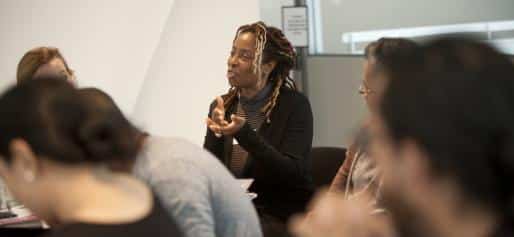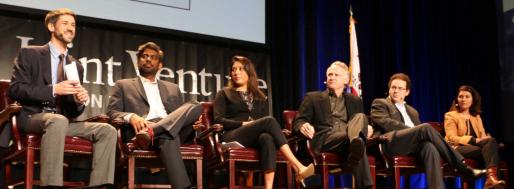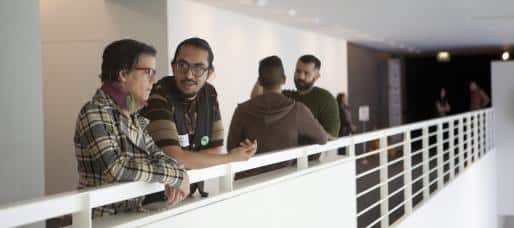If Your Board Looked Like Your Community
Moving board diversity from a ‘problem to solve’ to ‘something to practice.’ Staff and board talk common hurdles and how to overcome them.

You want a board to reflect changing demographics and engage with the community.
This story is part of New Faces New Spaces, a series by the Irvine Foundation exploring how arts organizations are adapting to reflect the changing demographics of California, engage with their communities, and become more resilient organizations. It was originally published on Medium and appears here under a Creative Commons license. Read Part 1, Part 2, and Part 3.
From #OscarsSoWhite to #parityraid, discussions of who is represented on our stages and our walls, within our organizations, on our boards, and in our field, abound. Our state of California has a rapidly changing demographic, our country has a growing problem with economic inequality, and we have research from as late as 2005 showing that seventy percent of 400+ arts organizations responding to a survey said that racial or ethnic diversity is “not at all” or “not too important” in the selection of new board members. What role should arts organizations play in this landscape?
As our grantee-partners in the New California Arts Fund are moving arts engagement to the core of who they are and what they do, they’re focused on evolving their approach to everything from audience development to board leadership and governance. While inclusive representation is just one component of a strong board, there are significant hurdles to overcome-logistic, strategic, and perceptual.
We spoke with eleven of the senior leaders and board members from four arts organizations participating in the New California Arts Fund to get their advice on how to overcome some common hurdles and why it’s worth diversifying your board.
During that process, Michael Garcés, Artistic Director of Cornerstone Theater Company asked (and answered), “What does it mean to have a commitment to diversity? It’s something that’s long-term and constantly interrogated, it’s never going to be ‘solved.’ It’s something we practice, just like the art form. You have to get over a discomfort with that.”
I’m looking forward to an engaging dialogue with the field, even if it surfaces some discomfort. I know the pay off for making ourselves uncomfortable with the status quo is that our learning will go deeper and we’ll be closer to making change.
If you haven’t started practicing already, or feel like you need to brush up on a few skills, I hope this resource compels you to take a tangible next step today.
– Josephine Ramirez, The James Irvine Foundation
Before you get started, here’s a quick look at the four organizations whose senior leaders and board members contributed to this story:
Cornerstone Theater Company
An ensemble-based theatre company making new plays with and about communities.
- LOCATION: Los Angeles
- ANNUAL BUDGET: $2,000,000
- BOARD SIZE: 20 Members
CONTRIBUTORS TO THIS STORY:
Michael Garcés – Artistic Director, Megan Wanlass – Managing Director, Ceci Dominguez – Board Member, Paula Ely – Board Member
MACLA (Movimiento de Arte y Cultura Latino Americana)
a contemporary arts space grounded in the Chicano/Latino experience.
- LOCATION: San Jose
- ANNUAL BUDGET: $1,000,000
- BOARD SIZE: 14 Members
CONTRIBUTORS TO THIS STORY:
Anjee Helstrup-Alvarez – Executive Director, Veronica Juarez – Board Member
Pacific Symphony
A symphony orchestra with a repertoire ranging from the masterworks to today’s most prominent composers.
- LOCATION: Orange County
- ANNUAL BUDGET: $20,000,000
- BOARD SIZE: 70 Members
CONTRIBUTORS TO THIS STORY:
John Forsyte – President, Mildred García – Board Member
San Francisco Shakespeare Festival
A theatre company and arts education provider making Shakespeare accessible to everyone.
- LOCATION: San Francisco
- ANNUAL BUDGET: $1,000,000
- BOARD SIZE: 15 Members
CONTRIBUTORS TO THIS STORY:
Toby Leavitt – Executive Director, Barbara Fatum – Board Member, Deborah Styles – Board Member

Yerba Buena Center for the Arts Fellows Retreat | Photo: Tommy Lau
Hurdle #1: Considering diversity an important qualification of board membership.
Recognizing the Opportunities a Diverse Board Brings
The common expectations for a board of directors are well known across the arts field-help us raise money, help us think and act strategically, and, for “working boards,” help us get the work done. But does who is on the board matter as much as what they’re doing? The first hurdle you might face in convincing the board to consider its own makeup is that representation matters.
Don’t consider the representation of your board because it’s good for you, do it because it’s necessary. Otherwise arts organizations are going to die of nobody caring.
– Michael Garcés
Cornerstone Theater Company’s Artistic Director Michael Garcés explained, “The focus of the board is often on fundraising, but their role can get distorted when you lead with that. Nonprofit theatres were created to support the community we exist in. We get a nonprofit tax status because we are in service to that community. Our board’s purpose is to ensure we fulfill our mission; raising money is just one way they accomplish that goal.”
Paula Ely, Cornerstone board member continued, “Our job as the board is to expand the network of Cornerstone-who attends performances and who financially supports us. Collectively, a more diverse board has a wider network of resources to bring to the organization. Our secondary role as the board is to participate in committee work, and having diverse points of view at the table helps us make better decisions.”
Twenty percent of the seats on the Cornerstone board go to “community board members” for whom financial capacity is explicitly not a factor in their board membership. Ely described how these community members “[are] on the board to keep it real for everyone else.
It’s fairly common for a community board member to have a unique insight into what impact our process has had on their community. They remind us why we’re doing what we’re doing, and how important the work that Cornerstone does is in the lives of real people and communities.”
That said, Ely rejected the notion that board members from diverse backgrounds wouldn’t also contribute financially. “People are out there. It’s important to have economic diversity, but it’s not true that every person of color needs that structure.
We don’t have to relax our standards to have a diverse board. There are plenty of very qualified, interesting, successful people out there. Some of them just haven’t been asked yet.”
A board representative of your community brings many benefits:
- Board members will be your advocates in their community. The more diverse your board, the more communities you have access to for potential audiences, donors, staff, artists, and other board members.
- A board composed of members from many different backgrounds and experiences enable you to solve problems more strategically because every member brings a unique lens to the issue at hand.
- Given the complicated (ongoing) history of diversity and inclusion in America, people who look, act, or think differently than “the majority” have likely learned unique adaptation skills that your organization will find valuable.
- It can be invigorating for a board to hear directly from the communities that are impacted by the art on your stage or your walls; a board member who is deeply embedded in one of those communities can serve as a constant guidepost.
- Maintaining a board representative of your community, with the capacity to help share that community’s story, is captured in the spirit of why boards exist in the nonprofit structure.
But Garcés warned, “Look at the demographics of the world changing around us. In any urban area, the change is absurdly present. Don’t consider the representation of your board because it’s good for you, do it because it’s necessary. Otherwise arts organizations are going to die of nobody caring.”
Getting Started
Two years ago, San Francisco Shakespeare Festival made a commitment to inclusive casting, to hire 50% actors of color across their season and achieve gender parity. “We had a background for these types of discussions. But it was still hard. Segmenting our board into specific categories goes against our culture of ‘y’all come,'” described Toby Leavitt, Executive Director at San Francisco Shakespeare Festival.
One of our board members recommended an inclusion consultant facilitate a discussion during a board meeting. Prior to the meeting, the board had many active conversations about the programmatic data demonstrating service to diverse and low-income Californians, and the artistic importance of, ‘holding the mirror up to nature,’ but we hadn’t yet started to talk in depth about how that should impact the board.
At the meeting, the consultant asked that we go around the room to answer a few simple questions. He led with his own personal story, in a very open and vulnerable way. He created a large enough space in the idea of ‘diversity’ for everyone to fit into. Some board members have been with us more than a decade, but never gotten to know each other this deeply.
It was only in talking about each board member’s own diverse backgrounds, heritages, and early experiences of difference that the subject came alive in the boardroom.
Your ability to talk about this is as important as your ability to review a balance sheet. By traveling this path together, real-time, with an expert guide, a shared commitment to diversify the board was forged.
San Francisco Shakespeare Festival board member Barbara Fatum echoed, “Having a consultant brought an organized look at how the board operates and where the board wants to go, and also encouraged discussion in ways that otherwise might not have occurred.”
Fellow board member Deborah Styles continued, “Before we go out in the community to recruit new members, we needed to have a certain amount of introspection as a group. The simplicity of the exercise brought out non-defensive and thoughtful responses.”
Your ability to talk about this is as important as your ability to review a balance sheet.
Toby Leavitt
Other practical advice from your colleagues in the field, as you think about beginning to bring diversity into the board conversation:
- Walk the talk in your own practices before you ask others to do the same. “It’s going to be hard to cultivate a diverse board if your programming and audience and staff are predominantly white and affluent.” Anjee Helstrup-Alvarez, Executive Director of MACLA.
- Explore different models of financial giving expectations for board members, particularly if you are concerned about the short-term negative economic impact of diversifying your board. “We have three options for board giving: give, give/get, and a “meaningful” contribution based on your personal circumstances, a gift that is among the three largest you give in a year.” Paula Ely, Board Member of Cornerstone Theater Company.
- Use hard data as a jumping off point. “I sit on another board that just hadn’t been educated about what Orange County looks like today. They live in neighborhoods where they don’t have a lot of exposure to the diversity of our community. I brought in census data for Orange County by age and ethnicity, how much it’s changed in the past ten years. They were blown away when I put the data in front of them.” Mildred García, Board Member of Pacific Symphony.
- Keep at it, even when it’s hard or uncomfortable or risky. “Don’t think of board diversity as a one-shot deal that you can talk about once and then it goes away. The leadership at the top needs to be committed to it, and use their pulpit to keep the organization focused on it. Take the time to talk about it, wrestle with all the complexity. If the board is fearful of change or skeptical of the value, it’s your job to convince them.” Mildred García, Board Member of Pacific Symphony.
Taking Action
Big change starts with small steps. Here are some examples of steps you can take today:
Facilitate a conversation with the board.
- What value would a more diverse board bring to your organization?
- What challenges might your organization face as you diversify your board?
Dive into the data about your community.
Data USA is a great resource for census data and other information about the make-up of your own community.

Cornerstone Theater Company presents “Urban Rez” | Photo: Kevin Michael Campbell
Hurdle #2: Defining your community and what it means for your board to be “representative.”
Choosing Who Is Important to Your Organization
“We worked with the DeVos Institute of Arts Management to create a description of our ‘ideal board,'” explained Anjee Helstrup-Alvarez, Executive Director of MACLA.
The”Ideal” MACLA Board
Board Composition in 2018
- Philanthropists – 20% (4)
- Visual Art 10% (2)
- Real Estate -5% (1)
- Finance – 2 (10%)
- Media -5% (1)
- Leaders of Latino Networks – 15% (3)
- Technology -20% (4)
- Academics-5% (1)
- Government-5% (1)
- Community Development – 5% (1)
- The MACLA Board consists of 20 members in 2018.
- It represents the following sectors: philanthropy, visual art (collecting), real estate, finance, media, leaders of high-profile Latino networks, media, technology,
academia, local government. - At least four members would be considered “socially- connected” philanthropists in San Jose, Silicon Valley, and San Francisco.
RESOURCE: An “ideal” board composition slide excerpted from MACLA’s “Ideal” Board Charter Presentation.
As an arts space grounded in the Chicano/Latino experience, MACLA is a little different. We’ve long had a board of Chicano and Latino community leaders, but not necessarily representative of the professions and economic capacity of broader San Jose and Silicon Valley.
We identified the skill sets and networks we had on the board, and the ones we still needed access to.
We’re being proactive in going after who we want to be reflective of our community — ethnically, socio-economically, professionally, generationally. The next generation of board members are already out there, and they won’t be balancing four other boards already.
As an ensemble-based company, Cornerstone focuses on how their board looks relative to the ensemble and the communities impacted by their work.
Diversity Statistics
| Total Board | 20 | |
|---|---|---|
| White | 13 | 65% |
| Latino/a | 3 | 15% |
| Asian | 1 | 5% |
| South Asian | 1 | 5% |
| African American | 2 | 10% |
| LGBT | 3 | 15% |
| Female | 13 | 65% |
| Male | 7 | 35% |
Giving Statistics
| Total Board | 18* | ** |
| Full Give | 12 | 67% |
| Give / Get | 4 | 22% |
| Community | 2 | 11% |
** Stated % goals are 50/30/20
Expertise
| Expertise | Current | Desired |
|---|---|---|
| Admin/Management | 3 | |
| Financial | 2 | |
| Law | 2 | |
| Marketing | 1 | |
| Theater Professionals | 1 | |
| Real Estate | x | |
| City/Government | x | |
| Technology | 1 | |
| Human Resources | 2 | |
| Entertainment | 3 | |
| Education | 1 | |
| Business Owner | 1 | |
| Banking | 1 | |
| Fundraising | x | |
| Investments | x |
RESOURCE: An excerpt from Cornerstone’s internal tracking spreadsheet of board diversity, giving, and expertise.
“Basically we make sure that our constituents are well-represented by our governance,” says Michael Garcés.
“Off the top of my head, we’re looking at financial capacity, origin, race, ethnicity, differently abled, age, profession, educational background, gender, sexual orientation, arts-based thinkers and practitioners, and other practical considerations based on where we are as a company.”
Paula Ely, board recruitment chair, continued, “We’re not super rigid about targets for categories. It’s more of an awareness of what’s heavy and what’s light, what would be nice to have, so we’re always balancing criteria and being realistic that sometimes it just happens to be the right time to move forward with a candidate.”
Getting Started
John Forsyte, President, Pacific Symphony described, “Our approach to board member recruitment is driven by our organizational strategy, goals, and values.”
Pacific Symphony I Board of Directors
Statement of Inclusion: Introduction (Working Draft)
A recently proposed strategic goal for Pacific Symphony is to attract, engage, and serve a larger and more diverse population in Orange County and the region. The more diverse the population we engage, the more our institution truly serves Orange County’s communities.
We maintain that achieving diversity requires an enduring commitment to inclusion that must find full expression in our organizational culture, values, norms and behaviors. Throughout our work, we will support diversity in all of its forms, encompassing but not limited to age, disability status, economic circumstance, ethnicity, gender, race, and religion.
Pacific Symphony recognizes that diversity exists in multiple dimensions, including differences among people that are not immediately visible.
RESOURCE: An in-progress draft of the introduction to Pacific Symphony’s Statement of Inclusion.
The reality is our board members need to have financial capacity, given the importance of their contributions to our budget. But there are a variety of factors that we look at: profession, age, gender, race, geography, diversity of thought.
And it’s about more than tokenism, everyone on the board needs a voice, not just a seat at the table. So we began drafting a diversity and inclusion statement that starts to put these ideas into something tangible.
Other practical advice from your colleagues in the field, as you define what diversity means for your organization:
- “Get some board champions, and get the board to articulate diversity itself, so it’s not just coming from you. And if your specific tactic isn’t working, it doesn’t mean change isn’t important. These are long, tedious conversations you need to have. People need to feel heard. Turnover will happen. Some people will be married to where the company was when they got here. You just have to weather it,” Michael Garcés, Artistic Director of Cornerstone Theater Company.
- “Attend performances and be aware of the audiences. Have an anecdotal feel for the community, what they’re feeling, what they look like,” Barbara Fatum, Board Member of San Francisco Shakespeare Festival.
- “Get below the rough cut of census data. Develop evaluation criteria for the staff and the board. Bring in more inclusion training. Resist the overly generic, ‘we just need more Asian Americans’ type sentiment, and instead focus on increasing cultural competency, not just adding new people to the board,” Toby Leavitt, Executive Director of San Francisco Shakespeare Festival.
- Find opportunities to instigate change, like winning the support of a new funder, undergoing a transition of leadership, or kicking off a strategic planning process. “Our grant from Irvine gave us a useful prompt to start codifying something inherent to our culture, but hasn’t been as deliberate as perhaps it should be,” John Forsyte, President of Pacific Symphony.
- Evolve your board as your community changes. “Tracking board diversity metrics is a dynamic process. We’re always trying to evaluate where we are now, what we are learning, and how we need to change as our community is changing.” Anjee Helstrup-Alvarez, Executive Director of MACLA.
Everyone on the board needs a voice, not just a seat at the table.
– John Forsyte
Taking Action
Definitions can make us uncomfortable. Here are some examples of steps you can take today:
Articulate your values about diversity.
Articulating your values can take many forms. Some boards have a “diversity statement” while others might develop a “charter” that defines their ideal board make-up.
Share your board recruitment criteria with the field.
Share your own (redacted) board recruitment spreadsheets with the field that identify the qualities you’re looking for in potential board members. Post a picture, link to a Google Spreadsheet, whatever you’re comfortable with, just share it on Twitter or Facebook using #showusyoursheets.

State of the Valley Conference in Santa Clara | Photo: Carolina Wilson (Peninsula Press)
Hurdle #3: Finding and recruiting new board members that are representative of your community.
Finding Them
“We look for board members in a variety of ways,” said Michael Garcés. “From business owners among our neighbors in the downtown arts district to colleagues of our existing board members to people we have met in the communities where we’ve worked. It’s a collective effort by the board, ensemble and staff to generate a list of potential new board members and then we work together on cultivation. Diversity is one of the many factors that we consider when evaluating new members.”
Paula went on, “The ensemble helps us recruit community board members, but to foster a diverse board, you have to get the whole board involved. Keep asking them. I’m sure they’re sick of me asking them, ‘Who do you know?’ But we also recognize our networks are limited. We just recently signed up to participate in the African American Board Leadership Institute. They have an amazing program that identifies African American professionals who are interested in board service but haven’t yet sat on a nonprofit board, and provides them weekend workshops about financial statements, fiduciary responsibility, other skills-based learning a board member needs. Then the Institute does match-making.”
Barbara Fatum, San Francisco Shakespeare Festival Board Member echoed, “Several board members have attended Board Match, a networking event that introduces nonprofits to prospective board members. We created a one page pitch that represents the mission, activities, and purpose of the Festival.”
“It could also be blindingly obvious,” said Toby Leavitt, Executive Director of San Francisco Shakespeare Festival. “I started googling and there are oodles of leadership groups in the area that we’ve never connected with, specific to different communities.”
“Social media is a whole new way of connecting with prospective board members,” mentioned Anjee Helstrup-Alvarez, Executive Director of MACLA.
State of the Valley talk
Dear Veronica,
Hello, I heard you speak at Joint Venture’s State of the Valley event earlier this month. You did an excellent job on the panel.
Based upon your interest in contemporary art I want to introduce you to MACLA (www.maclaarte.org) located in downtown San Jose. I’d appreciate the opportunity to meet at your convenience and see if you’d consider joining our Board of Directors as we have many exciting developments in the works.
Thanks in advance for your consideration.
Best wishes,
Anjee Helstrup-Alvarez
RESOURCE: A LinkedIn message from Anjee Helstrup-Alvarez (Executive Director of MACLA) to Veronica Juarez (Head of Enterprise Initiatives at Lyft).
“I was at a ‘State of the Valley’ event and saw Veronica Juarez (Head of Enterprise Initiatives at Lyft) speaking. I saw on her Twitter profile that she’s dialed into social justice and art, so I sent her a message on LinkedIn. She came down to MACLA for coffee and to learn more about our work. She’s been an incredible addition to the board.”
Recruiting Them
Veronica shared her side of the story, “When I met with Anjee, I got so excited. Anjee is clearly a visionary and incredibly motivated. I really appreciated how she reached out to me. She was a hustler about it. She didn’t know me, but she sent a really complimentary, heartfelt note on LinkedIn.
Seeing that quality in someone-to take ten extra steps-that means she’s doing that in every other area of the organization.
And as a board member, that’s the type of organization I want to support and be part of, someone who’s pushing beyond the typical ways of reaching out to find new audiences.
She also added three or four new board members at the same time, most of us were in our early 30s. It’s brought a new energy to the board, and really helps not to be the only one of a certain type on the board.”
Social Media is a whole new way of connection with prospective board members.
Anjee Helstrup-Alvarez
Taking Action
Reaching a diverse set of potential board members can require a diverse set of approaches. Here are some examples of steps you can take today:
Develop your board recruitment pitch.
You never know when opportunity will strike and a good board candidate will be right in front of you. Create a one sheet to keep in your back pocket that describes the value of joining your board and the responsibilities of a diverse board.
Reach out to someone new.
Social media is a great way to do your research and reach out to people you’re interested in potentially joining your board. Try LinkedIn or Twitter.

Yerba Buena Center for the Arts Fellows Retreat | Photo: Tommy Lau
Hurdle #4: Getting new and old board members to work together and learn from each other.
Letting Yourself Change
“Inclusion is about bringing in individuals that will have new ways of doing things; don’t let them assimilate into what you already have. That’s scary for institutions. It takes time, for people to share their ideas and fears,” advises Mildred García, Pacific Symphony Board Member.
My contribution is to be the voice of a community to the board.
– Ceci Dominguez
Cornerstone Community Board Member Ceci Dominguez described her experience of joining her first board, “I didn’t even know what a board was really or what a board member was supposed to do. I walked into my first board meeting and saw all the lawyers and corporate people and thought ‘What am I doing here?’
I was pretty shy and hesitant in the beginning, even though the board was really welcoming to me. I didn’t understand things about the budget. But the more I looked around and thought about it, I realized I did belong here.
My contribution is to be the voice of a community to the board, to keep them connected to the needs of the community in every decision they make. I talk about how I see the work that Cornerstone does impacting my community.”
Other practical advice from your colleagues in the field, as you onboard and integrate new members:
- Small groups can empower new voices. “It’s one thing to include people, it’s quite another to make them feel like they have a voice. Because we have a big board, we hear more honest comments in smaller, informal meetings, which are a better environment to hash out things. So we intentionally keep our board committees quite small,” John Forsyte, President of Pacific Symphony.
- Be transparent. “It’s more awkward for us than them, to talk about their capacity to give. Potential board members just want to know what’s expected,” Paula Ely, Board Member of Cornerstone Theater Company.
- Give board members a project to tackle. “In our work with DeVos, we realized that like many other boards, we were pretty inward-facing. The board was spending a lot of time in meetings reviewing financial statements, approving policies, hearing reports from different staff members, who themselves were spending a ton of time trying to assemble a giant board book for every meeting. We flipped the ratio, so now we’re giving fewer backward-looking reports and instead engaging the board with our artistic plans for the future, and giving them an opportunity to identify projects they want to take on, to enlist their friends and colleagues in helping us, which keeps everyone more engaged,” Megan Wanlass, Managing Director of Cornerstone Theater Company.
Taking Action
Even after the right people are in the room, it’s still hard work. Here’s a step you can take today:
Re-evaluate your board meeting agenda.
If you can commiserate with Megan about all the time spent preparing for backward- looking board reports, try flipping the ratio of your next board meeting agenda: more time spent on future looking opportunities for the board to get involved, less time for them to critique what’s already happened.
Not only will you save you and your staff prep time, you’ll also be enabling the board more opportunities to get to know each other and build bonds within a diverse team.

Cornerstone Theater Company presents “Urban Rez” | Photo: Kevin Michael Campbell
Of course, the hurdles never end. “You’re always responding to a changing environment — as board members rotate off, as the organization starts producing in or for a new community, as the community itself changes and your understanding of the community changes,” said Megan Wanlass, Managing Director, Cornerstone Theater Company.
While these stories from our four grantee partners and their boards represent diverse points of view and experiences, we know there are a lot more stories and examples in the field.
The Irvine Foundation wants to hear from you: What are the hurdles you’re facing in representing community on your board? Respond on the original post on Medium.
You might also like:
- Why Human-Centered AI Adoption Matters for Nonprofits
- The New Sheriff in Town: Tips for Successfully Leading a Nonprofit Team (that Someone Else Built)
- When the System Fails Quietly: What I’ve Learned from Sitting Between the Frontline and the Data
- A Board Member “Contract”
- Don’t Call it a Crisis Plan: How Nonprofits Can Proactively Plan for Turbulent Times
You made it to the end! Please share this article!
Let’s help other nonprofit leaders succeed! Consider sharing this article with your friends and colleagues via email or social media.
About the Author
Articles on Blue Avocado do not provide legal representation or legal advice and should not be used as a substitute for advice or legal counsel. Blue Avocado provides space for the nonprofit sector to express new ideas. The opinions and views expressed in this article are solely those of the authors. They do not purport to reflect or imply the opinions or views of Blue Avocado, its publisher, or affiliated organizations. Blue Avocado, its publisher, and affiliated organizations are not liable for website visitors’ use of the content on Blue Avocado nor for visitors’ decisions about using the Blue Avocado website.







Thank you for candid comments about diversifying nonprofit boards. Indeed, you have addressed critically important ideas. However, I am always amazed by the lack of context in most articles related to nonprofits. For example, we agree that effective ideas of how to diversify a board and what steps are needed are in fact critically important. Yet with the majority of nonprofits (approx. 65%) having fewer than 5 staff with annual operating budgets of less than $500,000, there are not enough staff and leaders to take on all the critical issues in a short amount of time. When we ignore the limited resources of “5 staff and less than $500,000”, we often expect too much too fast from the majority of nonprofits. The sheer number of “sound ideas/strategies” that are coming nonprofit leaders, day in and day out, do not reflect the majority of funding that “goes to direct service or programs! I believe in nonprofits and those who fund them, however I encourage us to keep refining the model of how we all interplay for the purpose of true, social change in our communities.